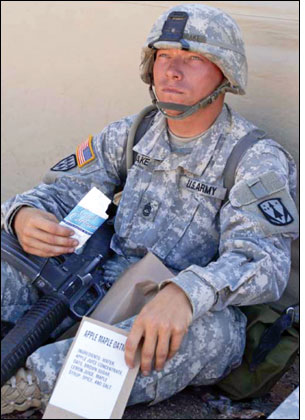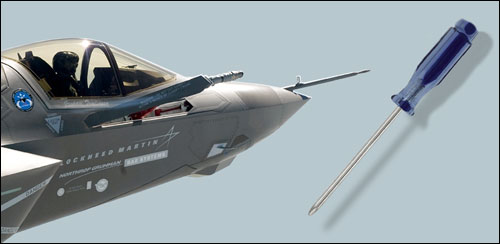Feb 01, 2012With the withdrawal of U.S. military forces from Iraq in December, the United States has been engaged in another important mission: "to quickly move equipment coming out of Iraq into depots to be rebuilt, and then shipped over to ongoing operations in Afghanistan," says Catherine Robertello, research fellow at LMI Government Consulting, who provides support to the Assistant Secretary of Defense for Logistics and Material Readiness Supply Chain Integration. Radio frequency identification has been helping to provide the visibility needed to complete the mission successfully. Having advance information on equipment that must be refurbished at depots streamlines arrangements for its receipt and preparations for whatever work must be done on it.
The United States plans to retain a presence in Afghanistan until 2014. Continental U.S. (CONUS) depots have to know what supplies to order, for example, to rebuild a truck for redeployment. The U.S. Department of Defense (DOD) Automatic Identification Technology (AIT), which encompasses both active and passive RFID for facilitating accurate and automatic data capture, "is an enabler for this mission, providing the folks working in the middle of the desert in Iraq with a technology that can be used to identify the equipment and streamline processes through the en route nodes to CONUS depots," Robertello says. "With visibility of what's coming, the depots can use the information to help schedule the retrograde repairs of equipment going out of Iraq and into Afghanistan."

The Defense Logistics Agency (DLA), the largest supplier of goods to the military services and itself a $42 billion global enterprise, manages 26 distribution centers worldwide. Eight years ago, the DLA began requiring its suppliers to RFID-tag cases and pallets. Today, its 18 CONUS distribution centers, including those in Hawaii and Guam, use a common warehouse-management supply system. By the end of February 2012, all these DLA facilities will use the EPC Gen 2 RFID tag and advance shipment notification (ASN) data during the receiving process.
In addition, individual services arms and defense agencies are engaging in discrete passive RFID deployments to reduce labor-intensive processes and increase safety, as well as to improve food safety for combat troops.
Yet, despite how far the DOD's RFID efforts have evolved, some questions linger—about everything from execution quality to date to how a squeeze in defense budgets may affect ongoing efforts.
Progress and Challenges
In October, the U.S. Government Accountability Office report "Warfighter Support: DOD Has Made Progress, but Supply and Distribution Challenges Remain in Afghanistan" acknowledged the challenges of tracking goods in a mountainous, landlocked country with a poorly developed infrastructure, and said the "DOD has more frequently met delivery standards for shipments transported by airlift than for shipments transported on surface routes."
The concerns cited in the report include a limited infrastructure of RFID readers along surface routes to and within the country, which hampers visibility, and the fact that not all data entered onto RFID tags meets DOD policy requirements for detail and accuracy. The latter leaves personnel without adequate information on shipment contents, hindering the ability to effectively plan for the receipt and onward movement of cargo at bases, the report said.
"In those locations like Afghanistan, maybe our infrastructure is not as robust as we would like it to be," says David Blackford, deputy division chief for ITV integration at the U.S. Transportation Command (USTRANSCOM). USTRANSCOM, as the DOD's lead proponent for AIT, led development of a plan to drive logistics business transformation by facilitating accurate and automatic data capture within an integrated end-to-end supply chain. Active RFID is the primary backbone for the strategic movement of container supplies by aircraft, ship or truck; passive RFID is employed at the pallet, case and item level, along with bar-code backup, for inventory management and receipt and storage improvements. USTRANSCOM works directly with the DLA, the armed services, combatant commands, the Office of the Secretary of Defense and all other stakeholders, to ensure the implementation of AIT across the DOD enterprise.
The Active to Passive ITV Chain
Today, active RFID technology for ITV is better integrated into business processes than passive RFID, LMI's Robertello says. "They are attempting to institute the use of passive tagging across the department to provide automatic identification of smaller-than-container-level items," she says. (Currently, what goes into an active-tagged container is typically recorded manually, and manual recording tends to be error-prone.) To accommodate this, all the services branches would need to change their automated information systems to interface with passive RFID tags. So, for example, when items are shipped from an installation in Texas to one in California to a base in Afghanistan, there would be a clear picture all along the way of exactly what items are where—and that discrete data could inform many business processes beyond ITV, such as receipt, storage and inventory management.
"If you could trust your RFID to say, 'Yes, this container has 8,012 items,' and I trust the RFID tag is telling me exactly from the supply and inventory point of view exactly what's in that container, then in a theater of war I don't have to use soldiers or contractors to count every item and put [the items] on the shelf, but just issue them out to the warfighters," says Patricia Kelly, an independent consultant on contract with LMI, supporting DOD and Department of Homeland Security clients. (Kelly and Robertello recently authored "Radio Frequency Identification Tags in Modern Distribution Processes," for the journal Army Sustainment, which explored these issues.)
"In a perfect world, in theory, they could be stuffing that container going to the war zone and tagging with passive tags everything going in that container," says Richard Kaniss, director of strategic partnerships at Motorola Solutions, who works with large defense contractors on passive RFID implementations. "That should be uploaded into an active tag that goes on the outside of the container, so everyone knows when it hits Kabul what's inside that container." What's holding things back is that the business process systems in use by the services in most cases have been browned out, and they're not investing in major changes because they're aiming to develop new systems, according to Kaniss. And all this is coming at a time when the DOD has to fight for budget dollars for many other critical requirements, such as modernizing installations and weapons systems.
Robertello points to work the Air Force has done to develop a data-collection layer that can sit atop its legacy system and process information from any automated identification technology, whether active or passive RFID, or bar code, to gain some leverage for AIT beyond ITV. "The beauty of that is we can perhaps use that data-collection layer to bring AIT use further into the business process, not just for the Air Force, but for other services as well," she says. "Sharing it with other services is the direction they are trying to go in."
Additionally, there still may be some long-term contracts that were signed before the tagging requirement was added, so those supplies being shipped in accordance with those contracts may be shipped without passive tags. Lieberman notes that advantages at facilities where passive RFID receiving has been implemented have included a 60 percent reduction in data-entry errors and a 29 percent increase in velocity from the time material arrives at the dock door to the time it's made available to a customer order from the shelf. "These two things, coupled together, provide enhancement to the ultimate customer, the warfighter, making materials more readily available in a timely manner and with accuracy," he says.
Special Ops
Various services arms and agencies have had success with some RFID applications beyond what was initially envisioned, according to USTRANSCOM's Blackford. The U.S. Army, for example, is tracking parachutes to identify those that malfunction. Packing errors can cause malfunctions, Blackford explains, "so if there's a malfunctioning parachute, they want to go back and find every other parachute that individual packer packed." In the past, every parachute held a paper log in its pocket with those details recorded manually, and when a problem occurred, service people would have to examine every one to identify others packed by the same person. "Now, they can do a quick scan with a handheld passive reader and find them much quicker, in minutes versus over an eight-hour day," Blackford says.
On another front, the U.S. Marines are testing long-range passive RFID technology, to see if it can improve inventory management of cargo periodically offloaded from ships strategically positioned at sea to deliver supplies on a contingency basis—if conflict breaks out, for instance. Every few years, these ships return to port for maintenance. When that's done at Blount Island Command, in Jacksonville, Fla., for example, the tagged cargo is stored on a roughly 25-acre lot. To take inventory, service personnel must drive electric carts outfitted with passive readers up and down the rows. "With long-range passive [tags], they wouldn't have to do that," Blackford says. "They could just hit a button to read an entire area and pull information and do inventory like that, which could be a real labor savings. And if it works, it could have applications for a variety of business processes at any military indoor or outdoor warehouse facility."
RFID vendor ODIN, which worked with the DLA as the integration partner for its passive RFID deployment, is collaborating with the U.S. Special Operations Command to develop a weapons-tracking system. "Handgun manufacturers are giving us permission and the legal right to embed RFID tags inside the weapons, without voiding the warranty and without affecting performance," says Patrick J. Sweeney II, ODIN's founder. "This is a huge deal." The benefit, he says, is its clandestine nature—it's unlikely a thief would know the weapon has an RFID tag, and if the weapon is ever recovered, the police can scan it to make a positive identification. "You can have admissible evidence to convict someone and traceability to convict someone," Sweeney says. "You know for sure that a gun is the one you say it is."
The DLA is building business processes that will use RFID data for making decisions to better support its four strategic distribution points (SDP) stateside. The SDPs store the largest majority of materials for shipments to support forward distribution point (FDP) sites, which include overseas locations. Now that it is possible to identify goods when they are received and their tags are read, Lieberman sees an opportunity to use the information to turn items immediately around for shipment to fulfill a customer order or to an FDP, without moving them first into storage. "Because we read the tag and match the ASN, we know the shipment needs to be immediately turned around, eliminating the storage and retrieval process," he says.
More end-to-end capabilities likely will be available to customers (U.S. military services and some civilian agencies), Lieberman adds. "We are working closely with all other AIT offices to keep abreast of their capabilities, to understand them and to build future plans," he says. "It's all about utilizing the data. The tag is just an enabler. The future goal is a fully automated, end-to-end, forward-and-reverse logistics process enabled by RFID." While Lieberman can't yet provide specifics of moving the use of passive RFID forward in relationships with DLA customers, he mentions that some advances are under evaluation in situations in which the DLA has taken over business processes it didn't manage previously, as part of base realignment and closure initiatives.
By 2015, the DOD's Concept of Operations plan calls for a widely integrated passive RFID vision, Blackford says. It will start with a supplier tagging an order for the DLA. That order will be consolidated with other tagged items in a multiwall container identified with a passive tag. The DLA will ship the container to a military service's customer, which will get an automatic receipt on delivery, and the RFID information will automatically update the service's inventory.
Among other benefits, this plan could ensure that received orders are closed out immediately; currently, it can take days for orders to be closed out, which can lead to repeat order requests that clog up the supply chain. "I'm not sure if we will hit that mark, because of the ERP legacy systems," Blackford says. "But our goal is to keep pressing again, as passive RFID is the next big supply-chain transformation, just as bar codes were about 30 years ago. There are compelling business cases out there. What we need to do is collaborate with stakeholders to ensure we are moving to the same goal. We know the technology works; it's just how we fit it into the business processes and get information integrated into IT systems."
The focus for RFID efforts in defense must be on the qualitative and quantitative benefits, Lieberman says, whether or not those benefits have a hard dollar value. "In today's environment of budget pressure, our focus is on business benefits, production efficiencies and logistics efficiencies," he says. "Moving any technology forward has to be supported with a business case, more now than ever."
In spring 2011, the U.S. Department of Defense started phase two of a pilot to determine the shelf-life stability of combat rations. Phase one had focused on identifying the most robust and accurate RFID system for the task. It had resulted in a model that combined battery-assisted passive RFID technology with an algorithm to support analysis of temperature data stored in the sensor-equipped tags, to learn how many days or weeks a product would be safe or nutritious to eat.
Phase two aims to validate that model, says Ismail Uysal, an assistant professor at the University of South Florida Polytechnic, which had performed the first pilot in conjunction with the University of Florida, the Georgia Institute of Technology and other partners. "For the first leg of testing, we have an average of 95 to 96 percent accuracy between what our model says and what shelf-life quality is in real life," according to food chemicals analysis, Uysal says.
Now, a next step is to develop tools to use this information for smart distribution of combat rations. "The typical warehouse receives shipments and sends them out in the order they come in," Uysal says. "We want to see if we can use the information to make informed decisions about shipping something closer to expiration first or to a closer location. So we are working with the U.S. Army's Natick Soldier Center to understand their complex combat-ration supply chain and see if we can… upload information from the RFID system to a common database they have… for rerouting in the supply chain." Uysal expects this work to be completed toward year–end.
Tagging for the DOD: Cost or Benefit?
In 2009, when RFID Journal examined how the DOD was using RFID to optimize its supply chain, many suppliers viewed the requirement to attach passive RFID tags to pallets of goods shipped to depots operated by the DLA, the DOD's logistics arm, as the cost of doing business. A few larger suppliers were working to incorporate RFID into their operations.
But some of the government's biggest defense contractors seem convinced that what was once a cost is now a benefit, says Richard Kaniss, who, as director of strategic partnerships at Motorola Solutions, works with large defense contractors on passive RFID implementations. Manufacturers are employing RFID internally, to drive cost savings and error correction on the manufacturing line, he says.
Some defense contractors are using RFID to support tool-management systems. "The bigger guys are saying, 'I do want to know where all my tools are for every toolbox, because the last thing I want is a Phillips screwdriver sucked into an F-35 Joint Strike Fighter engine," Kaniss says. "And the government doesn't pay me for goofing up an engine if there's a socket left in a missile that now goes haywire."
In addition, the government tends to supply specialized tools to its biggest contractors. Now, when government auditors come in, those tools can be precisely located much more quickly, Kaniss says.
While the DLA and first-tier suppliers may not be collaborating at a deep level, some big contractors are encouraging their suppliers to use passive RFID. "The big guys want to help their suppliers meet their requirements, because it makes it easier on them," Kaniss says, so they often provide expertise to those vendors.






